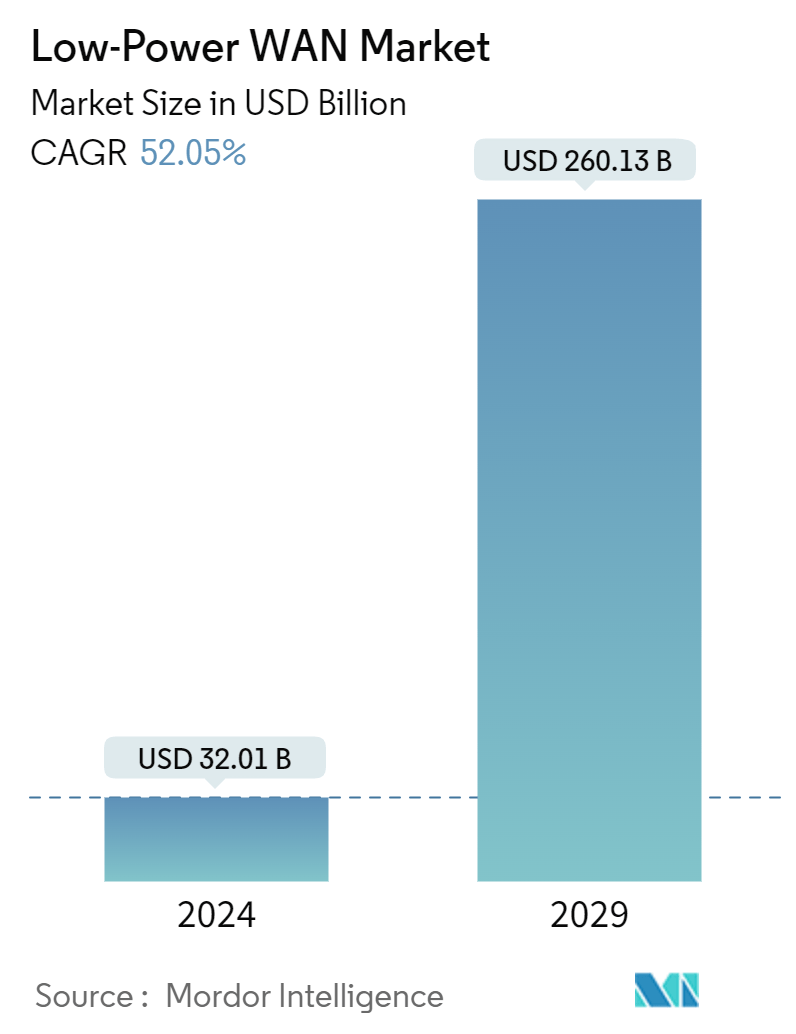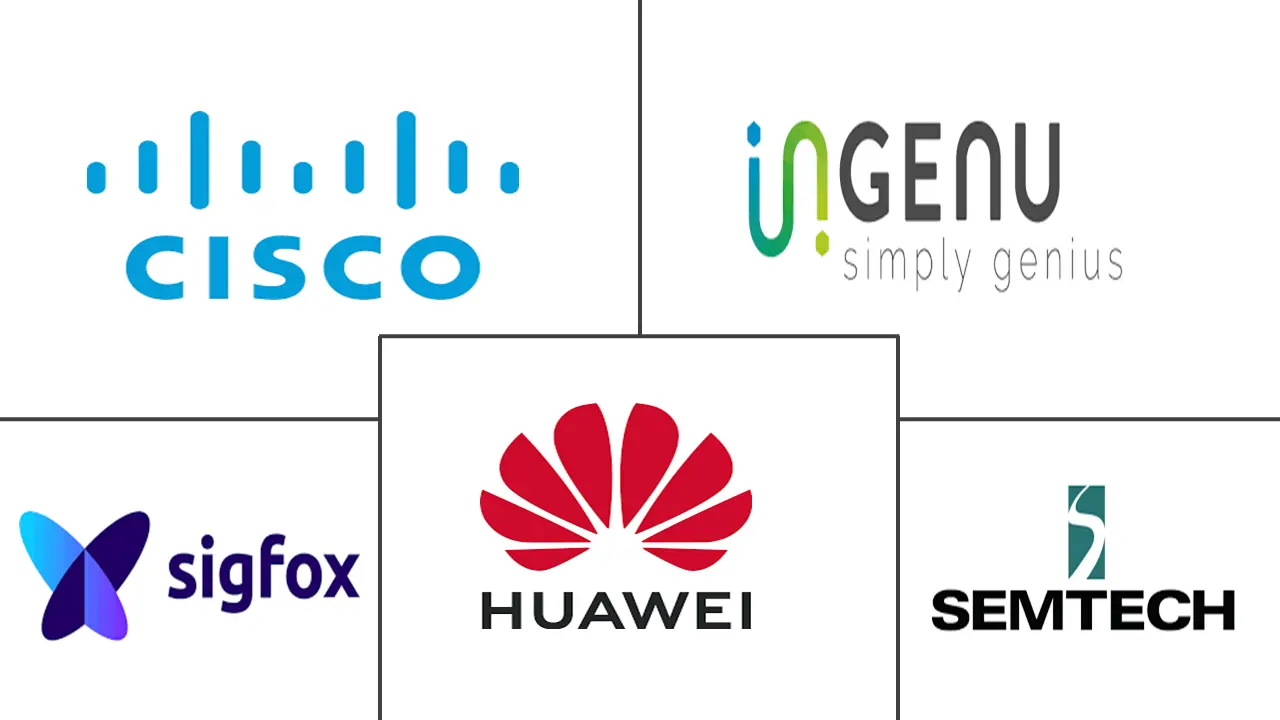Market Size of Low-Power WAN Industry

| Study Period | 2019 - 2029 |
| Market Size (2024) | USD 32.01 Billion |
| Market Size (2029) | USD 260.13 Billion |
| CAGR (2024 - 2029) | 52.05 % |
| Fastest Growing Market | North America |
| Largest Market | North America |
| Market Concentration | Medium |
Major Players
*Disclaimer: Major Players sorted in no particular order |
Low-Power WAN Market Analysis
The Low-Power WAN Market size is estimated at USD 32.01 billion in 2024, and is expected to reach USD 260.13 billion by 2029, at a CAGR of 52.05% during the forecast period (2024-2029).
- A low-power WAN (LPWAN) is a wireless wide-area network that connects low-bandwidth, battery-operated devices over vast distances at low bit rates. As the demand for low-power, wide-area connectivity in Internet of Things (IoT) applications continues to rise, the market is expected to grow during the forecast period.
- Given the mission-critical nature of industrial applications, the Industrial Internet of Things (IIoT) demands carrier-grade communication network reliability. High message ingestion rates are crucial, ensuring vital data is available for timely responses to potential issues. IoT sensors, spanning industries from asset tracking and human presence detection to air quality monitoring and leak detection, gather vast amounts of business-critical data. This data enhances operational visibility and efficiency and reduces cost, fueling market growth.
- In agriculture, these capabilities can double productivity and assist in monitoring crop development. LPWAN's ability to transmit small data volumes over long distances is expected to bolster market growth. Key applications of LPWAN include fleet management, GPS tracking, smart meters, smart grid management, home automation, waste management, process monitoring, and temperature oversight.
- However, future coverage and scalability challenges, technological coexistence, and real-time communication could impede LPWAN's widespread adoption and commercialization. Moreover, network security concerns arise, especially since it is deemed less reliable than direct data transmission to endpoints and may be susceptible to interference.
- Despite these challenges, LPWAN devices find global applications in sectors like industrial IoT, smart cities, smart homes, and utilities. Yet, vulnerabilities persist: root keys for encrypting communications between gateways, smart devices, and network servers can be targets for cyber-attacks. Such breaches can lead to DDoS attacks, data leakage, and false data injection, disrupting systems and hindering market growth. The FBI has warned about unpatched and outdated devices, highlighting the growing threat of cybercriminals exploiting vulnerabilities in internet-connected devices.
Low-Power WAN Industry Segmentation
A low-power wide-area network (LPWAN) is a particular network that enables long-range communication at a low bit rate. LPWAN overcomes the technological choice for constructing IoT networks globally. This wireless technology can be integrated into streetlights, cars, manufacturing equipment, home appliances, and wearable devices. LPWAN offers a plausible mix of long-range, low power consumption, and secure data transmission.
The low-power WAN market is segmented by type (NB-IoT, LoRaWan, and LTE-M), service (professional service and managed service), end user (oil and gas, consumer electronics, healthcare, industrial manufacturing, and logistics and traveling), application (smart meters, smart buildings, smart logistics, and smart agriculture), and geography (North America, Europe, Asia-Pacific, Latin America, and Middle East and Africa). The market sizes and forecasts are provided in terms of value (USD) for all the above segments.
| By Type | |
| LoRaWAN | |
| NB-IoT | |
| LTE-M | |
| Other Types (Sigfox, Weightless, etc.) |
| By Service | |
| Professional Service | |
| Managed Service |
| By End User | |
| Oil and Gas | |
| Consumer Electronics | |
| Healthcare | |
| Industrial Manufacturing | |
| Logistics and Travelling | |
| Other End Users |
| By Application | |
| Smart Cities | |
| Smart Homes/Buildings | |
| Smart Agriculture | |
| Other Applications |
| By Geography*** | |
| North America | |
| Europe | |
| Asia | |
| Australia and New Zealand | |
| Latin America | |
| Middle East and Africa |
Low-Power WAN Market Size Summary
The low-power WAN market is poised for significant growth, driven by the increasing demand for connectivity in Internet of Things (IoT) applications. This technology enables the connection of low-bandwidth, battery-operated devices over large distances, making it ideal for applications such as fleet management, smart meters, and home automation. The market's expansion is further supported by the rise of smart cities and the Industrial Internet of Things, particularly in regions like North America, where there is a strong focus on digital infrastructure development. Despite challenges such as network security and technological coexistence, the market is expected to thrive as LPWAN offers practical solutions for data transmission over unlicensed spectrum bands.
The market landscape is moderately fragmented, with key players like Cisco Systems Inc., Sigfox SA, and Semtech Corporation actively investing in technological advancements and market expansion. Recent developments include the introduction of new products and partnerships aimed at enhancing IoT solutions and expanding market reach. For instance, Semtech Corporation's LoRa technology and Sigfox's 0G technology are being integrated into various applications to improve connectivity and energy efficiency. These advancements, coupled with government support and consumer interest in future technologies, are expected to drive the adoption and commercialization of LPWAN solutions across different sectors.
Low-Power WAN Market Size - Table of Contents
-
1. MARKET INSIGHTS
-
1.1 Market Overview
-
1.2 Industry Value Chain Analysis
-
1.3 Industry Attractiveness - Porter's Five Forces Analysis
-
1.3.1 Bargaining Power of Buyers/Consumers
-
1.3.2 Bargaining Power of Suppliers
-
1.3.3 Threat of New Entrants
-
1.3.4 Threat of Substitute Products
-
1.3.5 Intensity of Competitive Rivalry
-
-
-
2. MARKET SEGMENTATION
-
2.1 By Type
-
2.1.1 LoRaWAN
-
2.1.2 NB-IoT
-
2.1.3 LTE-M
-
2.1.4 Other Types (Sigfox, Weightless, etc.)
-
-
2.2 By Service
-
2.2.1 Professional Service
-
2.2.2 Managed Service
-
-
2.3 By End User
-
2.3.1 Oil and Gas
-
2.3.2 Consumer Electronics
-
2.3.3 Healthcare
-
2.3.4 Industrial Manufacturing
-
2.3.5 Logistics and Travelling
-
2.3.6 Other End Users
-
-
2.4 By Application
-
2.4.1 Smart Cities
-
2.4.2 Smart Homes/Buildings
-
2.4.3 Smart Agriculture
-
2.4.4 Other Applications
-
-
2.5 By Geography***
-
2.5.1 North America
-
2.5.2 Europe
-
2.5.3 Asia
-
2.5.4 Australia and New Zealand
-
2.5.5 Latin America
-
2.5.6 Middle East and Africa
-
-
Low-Power WAN Market Size FAQs
How big is the Low-Power WAN Market?
The Low-Power WAN Market size is expected to reach USD 32.01 billion in 2024 and grow at a CAGR of 52.05% to reach USD 260.13 billion by 2029.
What is the current Low-Power WAN Market size?
In 2024, the Low-Power WAN Market size is expected to reach USD 32.01 billion.

